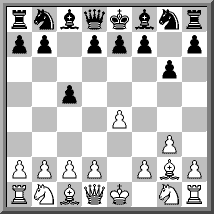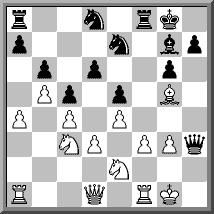Differences in style are often exaggerated by authors and journalists. Smyslov was often said to have a harmonious or universal playing style. Well, that's probably as true for him as for almost all top players.
Here is an example of him outplaying a weaker opponent, and it indeed looks simple. You may ask why I don't show a titanic struggle against Botwinnik or Kasparov. The answer is simply that I analysed this game when preparing a lesson on 1.g3, and I liked it.
V.Smyslov - M.Fuller, Politiken Cup (Copenhagen) 1980
1.g3
Smyslov was a versatile player who mastered most openings - including the possible transpositions between them.
1...g6 2.Bg2 c5
An invitation to a Closed Sicilian...
3.e4 (Dia)
...which Smyslov accepts. However, this exact position is less likely to arise from 1.e4 c5 2.g3, as then Black has 2...d5, which probably equalizes.
3...Bg7 4.Ne2
4.c3 may be slightly more flexible but after 4...Nc6, 5.Ne2 would transpose. We now have a position that could also arise from the move-order 1.e4 c5 2.Ne2 (an old Keres favourite).
4...Nc6
5.c3
This can be said to be the point of White's set-up. By holding back his queen's knight, he is able to better control the d4 square.
5...e5 6.0–0 Nge7 7.d3 d6
Or 7...0–0 8.a3 d5 when Dorfman-Magerramov, Beltsy 1979 somewhat surprisingly continued 9.exd5!? Nxd5 10.c4!? (these ideas are well known from the King's Indian with reversed colours) 10...Nc7 11.Nbc3 Bf5 12.Ne4 Ne6 13.Be3 Ncd4 14.Nxd4 exd4 15.Bd2 h5 16.b4 and White's position had more potential.
8.a3 Be6
A famous encounter continued 8...0–0 9.b4 b6 10.f4 exf4 11.gxf4 d5 12.e5 Bg4 13.h3 Bxe2 14.Qxe2 f6 15.b5 Na5 16.Nd2 fxe5 17.fxe5 Rxf1+ 18.Nxf1 Nb3 19.Rb1 Nxc1 20.Rxc1 Qc7 21.Re1 Rd8 with equality in Keres-Fischer, Candidates Curacao 1962.
9.b4 Qd7 10.Be3 b6 11.b5 Nd8 12.c4 (Dia)
12...0–0
12...Rb8 13.Nbc3 f5 14.f3 0–0 15.Qd2 Nf7 16.a4 h6 17.a5 g5 18.axb6 axb6 19.Ra6 += Fuller-Franklin, Brighton 1980.
13.Nbc3 Bh3 14.Bxh3 Qxh3 15.a4 f5 16.Bg5 f4
Black is untitled and not quite in Smyslov's league but a strong player who uses the tactical resources available to fight the grand old man.
17.f3 fxg3 18.hxg3 (Dia)
18...Bh6 19.Qd2 Bxg5 20.Qxg5 Rf7 21.a5 Ne6 22.Qg4
You could be forgiven for assuming that this queen exchange is an admission and expect the g-pawns will be a weakness in the endgame. However, as will soon be evident, the doubled pawns can not be attacked, they neutralize Black's kingside pawns, cover some useful squares, and the extra open file proves quite useful.
23...Qxg4 23.fxg4 Rxf1+ 24.Kxf1 Nc7 25.Kg2 (Dia)
25...g5?!
This creates a new weakness and simplifies White's task. After 25...Nc8 26.Nd5 Nxd5 27.exd5, White's advantage is also huge, and he can combine play in the a-file with ideas of a5-a6, completely immobilizing a knight on c8.
26.Nd5 Ncxd5 27.exd5 bxa5 28.Rxa5
White is now clearly better - maybe even winning as Black has no counterplay.
28...e4!
This probably is Black's best try, weakening c4 and taking away the e4-square from White's pieces. An example of more passive defence would be 28...Nc8 29.Nc3 Rb8 30.Na4 h6 31.Ra6 Kf8 32.Rc6 Ke8 33.Rc7 and Black is helpless.
31.e5!
In a sense this is the counterpart of Black's 28th move, weakening c5 and gaining access to e4 again.
31...dxe5 32.Kf3 Nxc4 33.Ke4 Rd8 34.Nc3 Rd7 35.Rc6 Kg7 36.Rxc5 Nd6+ 37.Kxe5
In a sense this is the counterpart of Black's 28th move, weakening c5 and gaining access to e4 again.
31...dxe5 32.Kf3 Nxc4 33.Ke4 Rd8 34.Nc3 Rd7 35.Rc6 Kg7 36.Rxc5 Nd6+ 37.Kxe5
White is a healthy pawn up and has the more active pieces.
37...Kf7 38.Ne4 Nxe4 39.Kxe4 Re7+
39...Ke7 40.Ke5 is not better.
40.Kf5 1–0
I am not sure whether Black lost on time or resigned in view of lines like 40...h6 41.d6 Re1 42.Rc7+ Ke8 43.Rxa7 Rb1 44.b6! Rxb6 45.Ke6 Rb8 46.Rh7.





